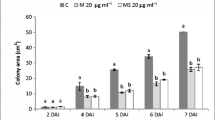Summary
The elicitation of perfect organs of fructification in the formgenusMicrosporon (pro parte) by means of an incidentally found bacterial symbiont, theB. weidmaniensis Benedek, 1938 is described.
Furthermore, it is reported on two strains ofMicrosporon which spontaneously yielded identical perfect organs of fructification in the primary culture without any stimulation.
A new genus is established:Veronaia Benedek (Ascomycetes, Perisporiaceae, Aspergillales) which encompasses at present, 1) the type species:Veronaia Castellanii,Benedek, 1960; 2)Veronaia (Microsporon)Audouinii Gruby and 3)Veronaia (Microsporon)felinea Fox &Blax.
The genusVeronaia is cleistocarp and homothallic.
The Latin and English diagnoses of the type species (genus) are given.
The historical importance of this discovery and its impact on future search for the perfect organs of fructification in dermatophytes is discussed.
Zusammenfassung
Die Auslösung einer typischen Schlauchfruktifikation in der Form-GattungMicrosporon (pro parte) mittels eines zufällig gefundenen bakteriellen SymbiontenB. weidmaniensis Benedek, 1938 wird beschrieben.
Ferner wird über zwei Stämme vonMicrosporon berichtet, die in der Primärkultur gleiche Schlauchfruktifikation spontan, ohne irgendeinen Reiz, geliefert haben.
Eine neue Gattung im natürlichen System wird aufgestellt:Veronaia Benedek (Ascomycetes, Perisporiaceae, Aspergillales). Sie umfasst zur Zeit 1) die Typen-species:Veronaia Castellanii Benedek, 1960; 2)Veronaia (Microsporon)Audouinii Gruby; 3)Veronaia (Microsporon)felinea Fox &Blax.
Die GattungVeronaia ist cleistocarp und homothallisch.
Die lateinische und englische Diagnose der Typen-species (Gattung) ist gegeben.
Die geschichtliche Bedeutung dieser Entdeckung und ihr Einfluss auf zukünftige Untersuchungen betreffs der Schlauchfruktifikation in den Dermatophyten wird erörtert.
Résumé
L'auteur reporte sur la découverte de la vraie forme de réproduction dans le forme-genreMicrosporon (pro parte) deSabouraud par le moyen d'un symbionte bactérien, leB. weidmaniensis Benedek, 1938, découvert incidemment.
En outre, il reporte sur deux souches deMicrosporon lesquelles ont produit la même forme parfaite de réproduction, spontanément dans la culture primaire sans aucune stimulation.
Un genre nouveau est établi:Veronaia Benedek, gen. nov. (Ascomycetes, Perisporiaceae, Aspergillales) en renfermant à présent (1) l'espèce-type:Veronaia Castellanii,Benedek, 1960; (2)Veronaia (Microsporon)Audouinii Gruby et (3)Veronaia (Microsporon)felinea Fox etBlax.
Le genreVeronaia est cleistocarpe et homothallique.
Le diagnostic latin et anglais est assigné à l'espèce-type (genre).
L'importance historique de cette découverte et son influence sur les recherches futures ont été discutées.
Similar content being viewed by others
References
Benedek, T. (1938). On a new species of the genus Microsporum, Microsporum Stilliansis, Benedek, 1937, nov.spec., with special consideration for the phenomenon of dissociation in Fungi Imperfecti. J. trop. Med., Apr. 1.
Benedek, T. (1943). Unilateral stimulation of Microsporum Audouini by a new species of bacillus. Mycologia,35(2): 222–242.
Benedek, T. (1948). On the newer trend of classification of dermatophytes. MycopathologiaIV, 3: 201–206.
Benedek, T. (1960). Critical survey of the present stand of the production of perfect stage of organs of fructification in dermatophytes. Mycopathol. et Mycol. Appl.13(4): 287–301.
Benham, Rhoda W.: Quoted afterHazen.
Chalmers, A. J. &Marshall, A. (1914). Tinea capitis in the Anglo-Egyptian Sudan. J. trop. Med.17(17): 257–265. Sept. 1.
Conant, N. F. (1936). Studies in the genus Microsporum. 1. Cultural studies. Arch. Derm. & Syph.33: 665–683.
Dade, H. A. (1960). Laboratory methods in use in the culture collection, in Herb I.M.I. Handbook, p. 40–69. Commonwealth Mycological Institute
Hazen, E. L. (1947). Microsporum Audouini: the effect of yeast extract, thiamine, pyridoxine, and Bacillus weidmaniensis on the colony characteristics and macroconidial formation. Mycologia,39(2): 200–209.
Nannizzi, A. (1926). Ricerche sui rapporti morfologici e biologici tra Gymnoascaceae e Dermatomiceti. Ann. Mycol.24, 1/2: 85–129 with 6 plates.
Nannizzi, A. (1927). Ricerche sull 'origine saprofitica dei funghi delle tigne. II. Gymnoascus gypseum sp.n. forma ascofora del Sabouraudites (Achorion) gypseum (Bodin) Ota et Langeron. Nota preventiva. R. Accademia dei Fisiocritici in Siena, April 29, 1927.
Author information
Authors and Affiliations
Rights and permissions
About this article
Cite this article
Benedek, T. Elicitation of perfect organ of fructification in Sabouraud's form-genus Microsporon (pro parte) by means of symbiosis with B. weidmaniensis Benedek, 1938. Mycopathologia et Mycologia Applicata 14, 101–122 (1961). https://doi.org/10.1007/BF02051459
Issue Date:
DOI: https://doi.org/10.1007/BF02051459




